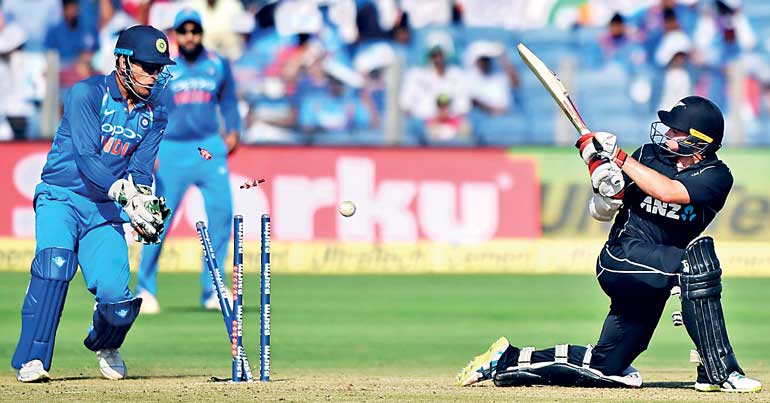Sunday Dec 15, 2024
Sunday Dec 15, 2024
Thursday, 26 October 2017 00:00 - - {{hitsCtrl.values.hits}}


ESPNCricinfo: New Zealand won the first ODI at the Wankhede Stadium courtesy their preparedness against India’s spinners, and the success of a key tactical move - swapping the batting positions of Colin Munro and Tom Latham. Three days later, following a trip down the Mumbai-Pune Expressway, India turned the tables with their own counter-tactics, on a pitch with just enough grass on it to allow their fast bowlers to bowl a traditional good length.
Bhuvneshwar Kumar finished with three wickets and Jasprit Bumrah with two, the two of them conceding only 83 in their 20 overs as New Zealand set India a target of 231 to level the series. The chase proved straightforward, with Shikhar Dhawan and Dinesh Karthik scoring half-centuries to lead India home with four overs remaining.
New Zealand’s fast bowlers didn’t begin half as well as their Indian counterparts, with Trent Boult and Tim Southee routinely pitching short in their new-ball spells. India hit seven fours in the first seven overs, and five of them came off the back foot, via pulls and punches and slashes over the slips. Rohit Sharma fell early, flicking Boult in the air, but the easy flow of boundaries meant New Zealand never put any pressure on the second-wicket pair of Dhawan and Virat Kohli, who added 57 off 56 balls. Kohli fell in the 14th over, driving away from his body at one that wasn’t full enough from Colin de Grandhomme, and Karthik walked in at No. 4, joining the endless carousel of batsmen to audition for the role in recent months. He began his innings with a boundary, guiding de Grandhomme between backward point and short third man, and ended the match with another - a sweetly timed on-the-up drive through the covers - but endured a bit of a struggle in between, never entirely fluent but always serving the interests of the chase.
New Zealand never managed two wickets in quick succession, with Karthik a constant thorn at one end: he added 66 with Dhawan for the third wicket, 59 with Hardik Pandya for the fourth, and an unbroken 28 with MS Dhoni for the fifth. The pitch wasn’t a belter, but it was still batting-friendly, and New Zealand hadn’t set a big enough target to force India into taking any real risks.
For that India will thank their bowlers, particularly Bhuvneshwar and Bumrah. Bowling a mix of slower balls and bouncers, India’s new-ball pair exposed Munro’s leaden-footed technique, and he plodded his way to 10 off 16 balls before Bhuvneshwar slipped a knuckleball through his defences. Before that, seam movement from a good length took out Martin Guptill and Kane Williamson, both stuck on the crease, the former nicking an away-seamer, the latter lbw to an inducker, and New Zealand were 27 for 3.
It was here that Latham came to the crease. During his unbeaten hundred in Mumbai, the sweep had been his most productive stroke, fetching him 26 runs off 16 balls and putting India’s pair of wristspinners off their lengths. India had responded by leaving out one of their wristspinners and bringing in the left-arm orthodox of Axar Patel - a flat, stump-to-stump, and therefore harder-to-sweep bowler. But before bringing Axar on, and as soon as the first Powerplay ended, India brought on Kedar Jadhav, who hadn’t bowled at all in Mumbai. With his round-the-wicket angle and low-arm release, Jadhav either angled the ball into Latham’s stumps or occasionally fired one wide of off stump, neither line conducive to the sweep, particularly given Jadhav’s lack of bounce. He bowled seven straight overs in his first spell, and only conceded 24, and in that time Latham played him with a studiously straight bat, only sweeping twice while scoring 11 off 23 balls.
Jadhav’s spell kept Latham in check, and in the time he was at the crease - in the company of Ross Taylor and then Henry Nicholls - New Zealand only managed 91 in 22.1 overs. The sweep appeared more frequently once Jadhav went out of the attack, but eventually the shot cost Latham his wicket, for 38 off 62 balls, as he failed to cover for Axar Patel’s switch to left-arm around.
The arrival of Colin de Grandhomme perked up New Zealand’s scoring, the allrounder playing a number of eye-catching flicks and on-drives while adding 47 for the sixth wicket at 5.42 per over with the more prosaic Nicholls. But just when the partnership was looking threatening, Bhuvneshwar broke it in the 38th over, when he returned for a two-over second spell. Again he hit that perfect length to prompt Nicholls to drive without getting a full stride forward, and again he found just enough movement to beat the inside edge and peg back leg stump.
Bhuvneshwar and Bumrah only conceded 12 in the last four overs of the second Powerplay, and perhaps this built extra pressure on de Grandhomme, who fell while trying to push the pace in the last over of spin, the 44th. Yuzvendra Chahal tossed one up wide of off stump, and de Grandhomme, reaching out for the big one, sliced a catch to short third man. Chahal’s next ball was a slider, which caught Adam Milne plumb in front.
New Zealand were 188 for 8 at this point. Mitchell Santner and Tim Southee ensured they would end up with a fighting total, courtesy a ninth-wicket stand of 32, but 230 was still decidedly below par.